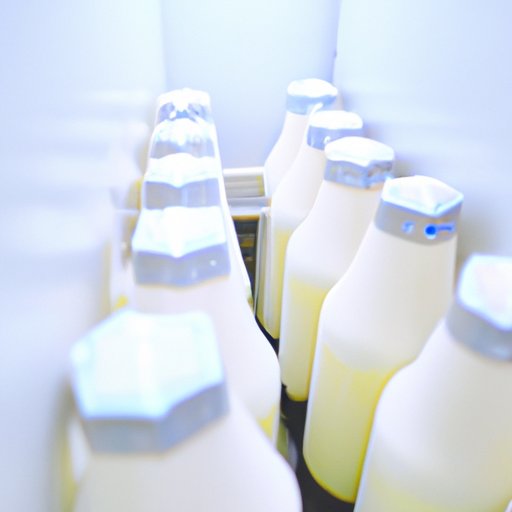Introduction
Milk is a versatile and nutritious food that can be enjoyed in a variety of ways. In order to ensure its quality, it’s important to store and handle it properly. One key factor to consider is the temperature at which it should be stored. But how cold does milk need to be?
When referring to “cold” temperatures, it’s important to note that this is relative to the environment in which it is stored. Milk should always be kept at a temperature below 4 degrees Celsius (40 degrees Fahrenheit). This is considered optimal for maintaining the best quality and flavor.
Refrigeration is essential for preserving the quality and safety of milk. Without it, the growth of bacteria can cause spoilage, leading to an unpleasant odor and taste. Keeping milk cold prevents the growth of harmful pathogens and preserves its nutritional value.
Exploring the Ideal Temperature for Refrigerated Milk
The optimal temperature for storing milk is between 0-4°C (32-40°F). At this temperature, bacteria growth is slowed down, allowing the milk to stay fresher for longer periods of time. It’s also important to note that milk should not be frozen, as this can damage its texture and flavor.
When determining how cold does milk need to be in your fridge, it’s important to check the temperature regularly. Most fridges have a setting that will allow you to adjust the temperature. The ideal temperature range for storing milk is between 2-4°C (36-40°F). If the temperature is too low, the milk may freeze, while if it’s too high, bacteria can start to grow rapidly.
It’s important to understand the guidelines for refrigeration when it comes to milk. For example, it’s recommended that milk be stored in the back of the refrigerator, away from the door. This helps to maintain a more consistent temperature and keeps it away from any sources of heat. Additionally, it’s important to make sure that the milk is sealed tightly to prevent air from entering and causing spoilage.
Keeping Milk Fresh: What Temperature is Best?
There are several tips for keeping milk at its freshest. First, it’s important to check the expiration date on the carton before purchasing. This will help to ensure that the milk is still safe to consume. Additionally, it’s important to store milk in the back of the refrigerator, away from any sources of heat. This will help to maintain a more consistent temperature and prevent spoilage.
It’s also important to make sure that the milk is sealed tightly to prevent air from entering and causing spoilage. Additionally, it’s important to store milk in the correct container. Glass containers or stainless steel containers are best, as they will help to preserve the flavor and texture of the milk. Finally, it’s important to make sure that the milk is consumed within a few days of opening.
Keeping milk at the right temperature is essential for preserving its quality and flavor. By following the tips outlined above, you can ensure that your milk stays fresh and delicious. Furthermore, by adhering to the recommended temperature guidelines, you can help to prevent the growth of harmful bacteria and preserve the nutritional value of the milk.
Conclusion
In conclusion, understanding the ideal temperature for storing milk is essential for preserving its quality and safety. Milk should be stored at a temperature between 0-4°C (32-40°F) in order to slow down bacteria growth and preserve its nutritional value. Additionally, it’s important to store milk in the back of the refrigerator, away from any sources of heat. Finally, it’s important to make sure that the milk is sealed tightly to prevent air from entering and causing spoilage.
By following the tips outlined above, you can ensure that your milk stays fresh and delicious.
(Note: Is this article not meeting your expectations? Do you have knowledge or insights to share? Unlock new opportunities and expand your reach by joining our authors team. Click Registration to join us and share your expertise with our readers.)
